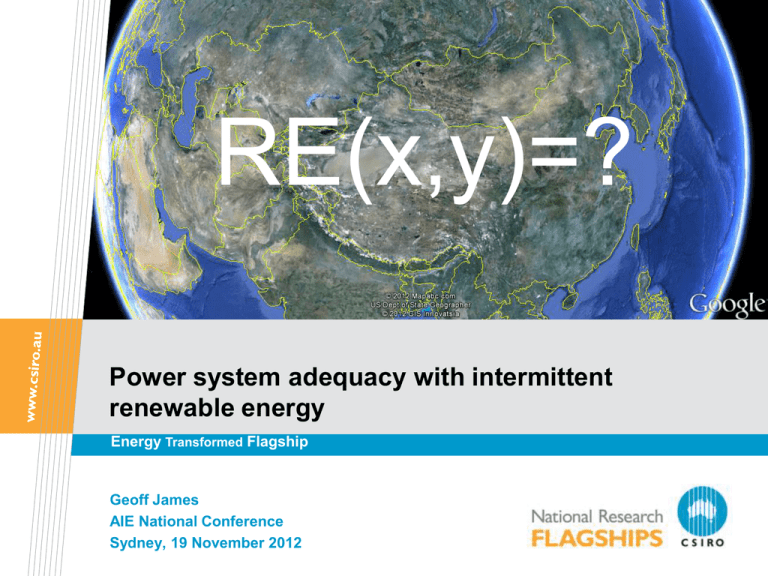Power system adequacy with intermittent renewable energy
advertisement

RE(x,y)=? Power system adequacy with intermittent renewable energy Energy Transformed Flagship Geoff James AIE National Conference Sydney, 19 November 2012 Important influences in the Asian region • Universal access to clean energy • There are 800 million Asians relying on basic fuels (Asian Development Bank) • The best overall solution is likely to be a mixture of interconnected grids and separate regional grids – or interconnected and local energy supplies in an Australian context • Interconnection and trading • Increased quality and diversity of renewable resources that may be accessed and traded – each region can use its best resources • Long-distance interconnection by HVDC transmission creates a new dispatchable resource for grid management • The emergence of energy storage • Storage will modify demand, smooth supply, and create a new dispatchable resource for operators of clean grids Geoff James, Power system adequcy with RE, 19/11/2012 Question about system adequacy • Presuming that power grids will trend towards majority renewable energy supply and that much of this will be intermittent • Allowing that the purpose of power grids of any size is to balance supply and demand continuously • Given (historical) knowledge of the renewable energy resource over an interconnected region • How much installed generation capacity will be needed (and where) to ensure system adequacy? • Minimising the overall installed capacity • Maximising the proportion of renewable energy supply • With or without consideration of transmission capacity Geoff James, Power system adequcy with RE, 19/11/2012 Reliability = security + adequacy • Security of the power system • Physical, information technology, and communication threats • Thermal, transient, voltage, oscillatory instabilities • Adequacy of generation, transmission, substation, and distribution infrastructure to meet the electrical load at all times • Without violating system voltage and frequency limits • In the presence of planned and unplanned outages (e.g. N-1 contingencies) • Separate measures for installed adequacy and operating adequacy • Typical requirement for interconnected power systems • Loss-of-load expectation (LOLE) is less than 0.1 days per year • Expected energy not served (EENS) is less than 0.002% of total consumption Geoff James, Power system adequcy with RE, 19/11/2012 Renewable & fossil-fuel generation capacities Type Capacity Variation Intermittent RE R(x,y) r(t) ≤ R(x,y) Fossil fuel G g(t) ≤ G Load L l(t) ≤ L r (t ) R( x, y) ( x, y, t ) dx dy A Generating “efficiency” of the installed RE capacity according to the weather Geoff James, Power system adequcy with RE, 19/11/2012 Begin with generation-only risk assessment Ignore transmission R(x,y) G L With transmission R(x,y) G(x,y) L(x,y) • A fast optimisation method can compute R(x,y) and G • Tested with wind and solar and extensible to represent a diverse mix of sources • Hydro generation h(t) ≤ H • Biomass generation b(t) ≤ B and potentially separate treatment of biogas generation • Geothermal generation u(t) ≤ U Geoff James, Power system adequcy with RE, 19/11/2012 Wind deployment with unconstrained G Outcome: maximum capacity factor! • Optimise using 30-min intervals over 1 year (17,600 constraints) • Resolution 1 degree in latitude and longitude (1,500 unknowns) Geoff James, Power system adequcy with RE, 19/11/2012 Solar deployment with unconstrained G Outcome: maximum correlation with load! • Now introducing ramp-rate limits for fossil-fuel generation plants • Also constraining the emissions (= maximising RE penetration) Geoff James, Power system adequcy with RE, 19/11/2012 Traditional way to model generation availability Wenyuan Li. (2005). Risk Assessment of Power Systems. IEEE on-line. • Artificial time series for generation availability using MTTF and MTTR Geoff James, Power system adequcy with RE, 19/11/2012 Combine with artificial load to calculate LOLE Wenyuan Li (2005). Risk Assessment of Power Systems. IEEE on-line. • But for an accurate result the simulated period can be many years! Geoff James, Power system adequcy with RE, 19/11/2012 New way to model generation and load Keane et al. (2011). IEEE Trans. Power Systems 26 (2), 564-572. • Recommends a Preferred Methodology for calculating system adequacy with wind generation • Each generator capacity and FOR is convolved via an iterative method to produce the capacity outage probability table (COPT) of the power system • The COPT of the power system is used in conjunction with the hourly load time series to compute the hourly LOLPs without the presence of the wind plant • The annual LOLE is then calculated • This approach uses coincident time-series data for load and renewable generation output – and these are significantly correlated • The fast optimisation method can include LOLE and EENS calculated this way as optimisation targets Geoff James, Power system adequcy with RE, 19/11/2012 Energy storage to balance supply and demand • Energy storage options and costs have been compared in the context of high-penetration RE future for the National Electricity Market • James and Hayward (2012). AEMO 100% Renewable Energy Study: Energy Storage. CSIRO, Australia. Available on the DCCEE website. • Several technologies available at grid scale were studied • • • • Solar thermal storage using molten salts Storage of biomass solids – and production and storage of biogas Compressed air energy storage (CAES) Three different battery technologies • Pumped hydro storage was analysed in detail by another consultant • ROAM Consulting (2012). Pumped Storage modelling for AEMO 100% Renewables project. ROAM, Australia. Also available on the DCCEE website. Geoff James, Power system adequcy with RE, 19/11/2012 Storage costs as $/MWh of delivered energy which depend on a number of assumptions about operating regimes Woody biomass solids Crop biomass solids $1,000 Repurposed lithium-ion Advanced lead-acid Above-ground CAES Underground CAES $100 Zinc-bromine Pumped hydro Biogas from MSW CST with molten salt 1 hour Geoff James, Power system adequcy with RE, 19/11/2012 Biogas from woody/crop sources 1 day 30 days Deciding what to do with biomass Available biomass solids fb Use for “baseload” generation fs Direct to solid biomass storage fg Direct to biogas storage 1 fb f s f g Geoff James, Power system adequcy with RE, 19/11/2012 Not used Flow rates in biomass electricity generation Rgenerate Rharvest Rtransport Geoff James, Power system adequcy with RE, 19/11/2012 Availability of woody biomass in 2030 Exclusions used to help identify the resource that can be responsibly and sustainably harvested Geoff James, Power system adequcy with RE, 19/11/2012 Availability of crop & stubble biomass in 2030 Complements quite well the availability of woody biomass Geoff James, Power system adequcy with RE, 19/11/2012 The East Australian biogas storage network Storage capacity on the gas pipeline network Gas Electricity measure measure 150 PJ 14.6 TWh Processing and transmission capacity of the network 4 PJ/day Parameter Geoff James, Power system adequcy with RE, 19/11/2012 16.2 GW CSIRO Energy Technology Geoff James Principal Research Scientist Phone: +61 401 681 282 Email: geoff.james@csiro.au Web: www.det.csiro.au Thank you Contact Us Phone: 1300 363 400 or +61 3 9545 2176 Email: Enquiries@csiro.au Web: www.csiro.au




